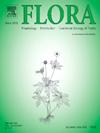Hybrids of broad-leaved Potamogeton (Potamogetonaceae) are common in Siberia
IF 1.7
4区 生物学
Q3 ECOLOGY
引用次数: 0
Abstract
We have summarized the distribution of Potamogeton hybrids in Siberia based on extensive field and herbarium work. Four most common broad-leaved Potamogeton hybrids, P. × angustifolius, P. × nitens, P. × salicifolius and P. × sparganiifolius, and one very rare P. × cognatus occur in 178 localities, of which 108 are newly reported ones. Hybrids are mostly found in areas where both parental species are common and the research activity is high. Unlike Europe where both hybrid diversity and frequency of occurrence increase with latitude, in Siberia both diversity and frequency peak south of 60° N, which is the northern distribution limit for many Potamogeton species due to the more severe continental climate of Siberia. Habitat preferences of the hybrids depend on the dominant type of water bodies and the suitability of environmental conditions in the area. In the southern lowlands, most records of hybrids are made in rivers. At higher elevations (>800 m a.s.l.) or at the northern and western distribution limits, Potamogeton hybrids were found in lakes or stagnant water bodies.
我们根据大量的实地考察和标本馆工作,总结了西伯利亚 Potamogeton 杂交种的分布情况。× angustifolius、P. × nitens、P. × salicifolius 和 P. × sparganiifolius,以及一种非常罕见的 P. × cognatus,它们分布在 178 个地方,其中 108 个是新报道的。杂交种大多出现在亲本物种都很常见、研究活动频繁的地区。在欧洲,杂交种的多样性和出现频率都会随着纬度的增加而增加,而西伯利亚则不同,在北纬 60 度以南,杂交种的多样性和出现频率都达到了顶峰,由于西伯利亚的大陆性气候更为严酷,因此北纬 60 度是许多 Potamogeton 物种的分布极限。杂交种对栖息地的偏好取决于该地区水体的主要类型和环境条件的适宜性。在南部低地,大多数杂交种的记录都出现在河流中。在海拔较高的地区(海拔 800 米)或分布范围的北部和西部,杂交种出现在湖泊或死水中。
本文章由计算机程序翻译,如有差异,请以英文原文为准。
求助全文
约1分钟内获得全文
求助全文
来源期刊

Flora
生物-植物科学
CiteScore
3.30
自引率
10.50%
发文量
130
审稿时长
54 days
期刊介绍:
FLORA publishes original contributions and review articles on plant structure (morphology and anatomy), plant distribution (incl. phylogeography) and plant functional ecology (ecophysiology, population ecology and population genetics, organismic interactions, community ecology, ecosystem ecology). Manuscripts (both original and review articles) on a single topic can be compiled in Special Issues, for which suggestions are welcome.
FLORA, the scientific botanical journal with the longest uninterrupted publication sequence (since 1818), considers manuscripts in the above areas which appeal a broad scientific and international readership. Manuscripts focused on floristics and vegetation science will only be considered if they exceed the pure descriptive approach and have relevance for interpreting plant morphology, distribution or ecology. Manuscripts whose content is restricted to purely systematic and nomenclature matters, to geobotanical aspects of only local interest, to pure applications in agri-, horti- or silviculture and pharmacology, and experimental studies dealing exclusively with investigations at the cellular and subcellular level will not be accepted. Manuscripts dealing with comparative and evolutionary aspects of morphology, anatomy and development are welcome.
 求助内容:
求助内容: 应助结果提醒方式:
应助结果提醒方式:


